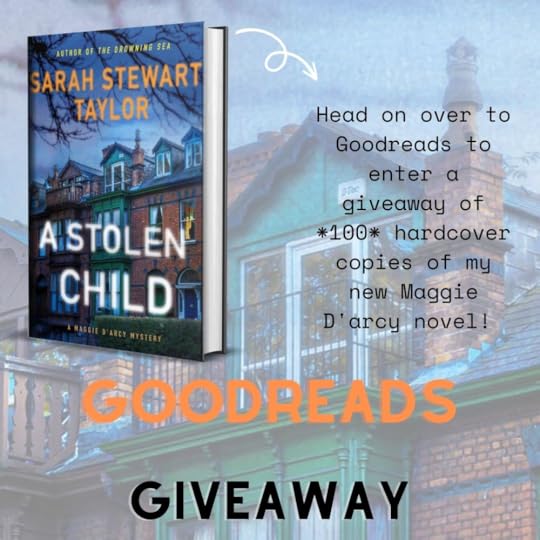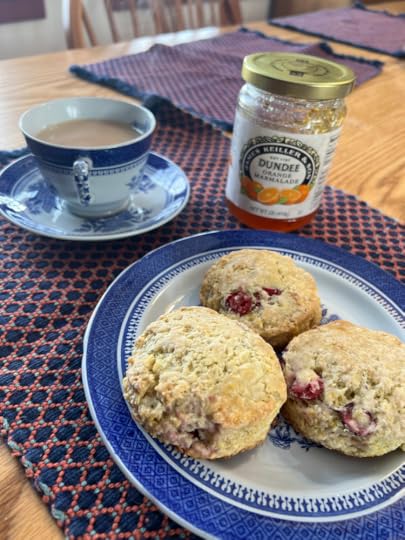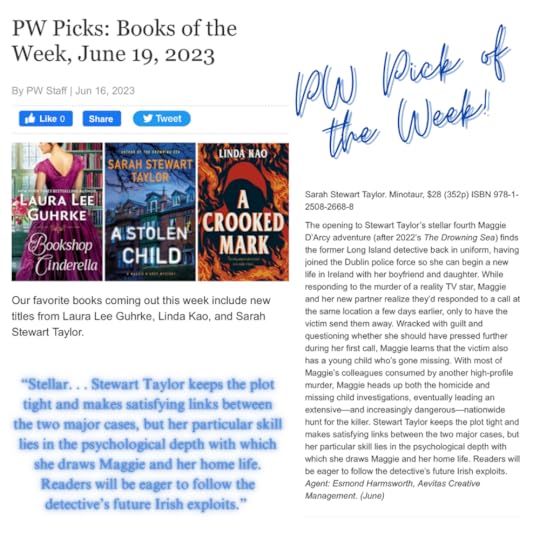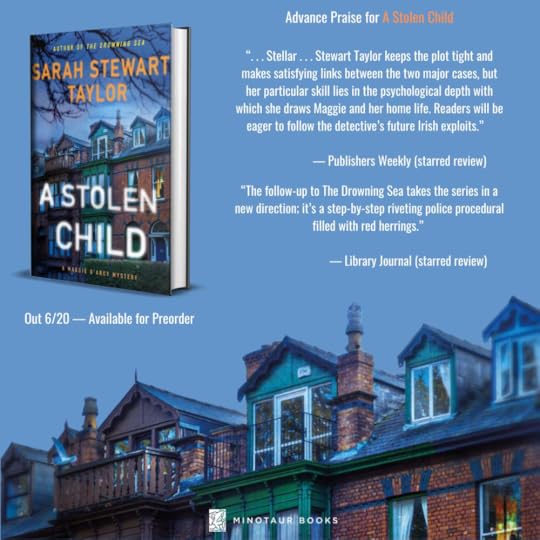Sarah Stewart Taylor's Blog, page 2
October 29, 2023
Apple Cider Donuts
These are one of the best things about Vermont in the fall. At orchards, farmstands, and bake sales, you'll find a lot of different interpretations of the apple cider donut.
When I decided to master this New England classic, I was looking for three main things: crunchy, deep-fried deliciousness; strong apple cider flavor; not too sweet.
If you search for cider donut recipes, you'll find a lot of recipes for baked donuts. I am sorry, but if it's baked, it's not a donut. It's a cake. It may taste pretty good, but it's not a donut. As for the apple cider flavor, there's only one way to get that: boiled cider. Any recipe that doesn't call for boiled cider isn't going to achieve that apple flavor. And finally, a lot of the recipes I tried were much too sweet. I landed on a combination of brown and white sugar in lesser amounts and also, some cloves and cardamom in the spice mixture to complicate the flavor profile a bit. Here is my apple cider donut recipe, which is a combination of many of the more popular recipes I found. Make them as often as you can for the next few weeks or so!
Apple Cider Donuts
Mix together in a large bowl:
3 1/2 cups flour
½ cup brown sugar
½ cup white sugar
2 ½ teaspoons baking powder
½ teaspoon baking soda
1 teaspoon salt
1 tablespoon cinnamon
1 teaspoon nutmeg
½ teaspoon cardamom
½ teaspoon cloves
Mix together and then add to dry ingredients:
4 cups of fresh apple cider (not juice, cider), boiled down until it's about 1 cup
6 tablespoons melted butter
2 eggs
½ cup of buttermilk
Stir until it forms a wet, sticky dough. You can chill the dough to firm it up a bit or you can start cutting out your donuts. It's best to get them all cut out before you start trying to cook them. Put a lot of flour on your cutting board or silicon mat and form the dough into a rectangle. Put a lot more flour on top and roll it out until it's about 3/4 inch thick. Then use a donut cutter to cut out the donuts. Let them sit while you pour about three inches of vegetable oil into a pot or dutch oven and heat it to about 175 degrees F. Start lowering the donuts and donut holes carefully into the oil with a slotted spoon and allow to cook until golden brown on one side before turning and letting the other side get golden brown too. Then drain on paper towels, roll in cinnamon sugar and serve!
October 3, 2023
Agony Hill is Coming August, 2024

My new Vermont-set mystery, Agony Hill, comes out August 6, 2024. Stay tuned for a cover reveal and lots more information! In the meantime, here's the jacket copy my publisher will be using for the book.
Set in rural Vermont in the volatile 1960s, Agony Hill is the first novel in a new historical series full of vivid New England atmosphere and the deeply drawn characters that are Sarah Stewart Taylor's trademark.In the hot summer of 1965, Bostonian Franklin Warren arrives in Bethany, Vermont, to take a position as a detective with the state police. Warren's new home is on the verge of monumental change; the interstates under construction will bring new people, new opportunities, and new problems to Vermont, and the Cold War and protests against the war in Vietnam have finally reached the dirt roads and rolling pastures of Bethany.Warren has barely unpacked when he's called up to a remote farm on Agony Hill. Former New Yorker and Back-to-the-Lander Hugh Weber seems to have set fire to his barn and himself, with the door barred from the inside, but things aren’t adding up for Warren. The people of Bethany—from Weber’s enigmatic wife to Warren's neighbor, widow and amateur detective Alice Bellows — clearly have secrets they’d like to keep, but Warren can’t tell if the truth about Weber’s death is one of them. As he gets to know his new home and grapples with the tragedy that brought him there, Warren is drawn to the people and traditions of small town Vermont, even as he finds darkness amidst the beauty.
June 19, 2023
April 20, 2023
February 7, 2023
Goodreads Giveaway
Do you use Goodreads? If so, you'll want to head on over and enter the giveaway my publisher is running for 100 hardcover copies of the new Maggie D'arcy novel, A Stolen Child!

February 1, 2023
Scones
Scones can be wonderful or terrible. Many years ago, I had oat scones at a friend's family home outside Dublin. I can still taste and smell the warm little pillows, the cold Irish butter, and the homemade jam. Those were the ideal scones. But I've had so many stale, heavy, bad ones (many of them made by me) that until recently I had kind of given up on them. While I love baking, the perfect scone has always eluded me. I think it's because though we sometimes treat them like cakes, scones are actually pastry and the Cutting in of the Butter is the key to success. I have always had more luck with recipes that don't require things to be precisely, well, precisely anything. A cake or cookie batter is more forgiving than a pie crust or scones, where the exact temperature of the butter can be the difference between success and failure. I've made some bad scones in my life, heavy, sodden ones more like hockey pucks than airy clouds of butter and flour. Recently, I decided to conquer scones once and for all. I think I've done it.
I love Irish scones and I've had good results with both Darina Allen's White Scones and this recipe from Irish-born chef Gemma Stafford. Both of these recipes make delicious scones that are excellent canvases for whatever jam or curd you want to put on them.
But the recipe that I come back to again and again is this one, from . . . The Dairy Farmers of Canada. These scones have fresh, chopped cranberries and a delicious hint of citrus. I replace the lemon juice with orange juice and add orange zest because cranberry and orange are just meant to go together. Keep a bag of cranberries in your freezer and you'll be ready to make these any time you need a plate of warm, flaky deliciousness to serve guests or keep for yourself.

December 1, 2022
Top Five Writing Tips
I was recently giving a talk about my books and an audience member asked me for my top writing tips, the ones I have come to after a lot of trial and error. It was a great question, though I had to think hard to come up with them on the fly. This is not an exhaustive list and I really believe we all need to learn what works for us as individual writers (see tip#1). But here they are, my greatest hits of writing advice:

1. Don't try to be someone you're not. Instead, learn about yourself as a writer and what works for you. I see a lot of very prescriptive writing advice — Use My Surefire Six-Step Process and Write a Novel in a Month! — out there and it makes me uncomfortable. Outlining a book down to the tiniest detail might work for some writers, but for others it's just wasted effort because everything will change once things are underway. If you know you need to be surprised and to have a sense of discovery as part of your creative process, then detailed outlining won't work for you. If you have to know where you're going in order to settle into your story, then planning ahead will likely help you be more productive. The only way to learn about yourself as a writer is to try a few different approaches and see which one fits you best.
2. If you're not sure where your story is going, ask yourself if you have a plot or a premise. Often, we start writing novels or stories with a premise. A woman discovers that her brother was actually kidnapped as an infant by her parents. It's exciting and promising, but it's not a plot. The plot is all the things will happen when the woman decides how she will respond to this new knowledge. What actions will she take that will change everything in her family? How will her brother and her parents respond to her actions with actions of their own? Plots are like trains traveling down one branch of a multi-track rail system. Each choice your characters make leads to other choices that irrevocably change the path they travel through the story.
3. Spend some time with your characters. When I find myself stuck, it's often because I don't know my characters well enough. I don't really understand their choices and motivations. Spending some time working on the characters' backstories — where were they and what were they doing before they walked into the book? — can help shake plot possibilities loose. I also like to spend some time asking myself what my characters want. What does she want out of her life? What does he want out of his marriage? What does she want over the course of the novel? What does he want in this scene?
4. Take a break. When you've finished a draft or reached an important milestone in the writing of the manuscript, take a break and give it some time to settle. Time is the best writing tool and walking away from a book I've been swimming in for months is my most surefire method for solving problems and coming to understand what I'm actually writing about or which character's story is actually at the center of my plot. I find long walks are the best way to figure things out. Hot baths are a close second.
5. In a perfect world, I would write every single day. The world is not perfect. While I do need to put in six- or seven-hour workdays at least five days a week in order to get a book written, I also know that there are days where I'm just not going to be able to write a lot of words. What I've learned is that if I can't put in a real writing day, I can keep the momentum going by making contact with the manuscript every day. If I open it up, read the last scene I wrote, work on one paragraph in the time I have, then my brain keeps writing, even while I'm away from my desk.
November 30, 2022
Bûche de Noël
I made my first Bûche De Noël (or Yule Log) ten years ago. It seemed like a fun and creative project with kids — all those cute meringue mushrooms — and I had offered to make a dessert for a holiday gathering. So I searched for a recipe and dove in. Twenty-four hours later I was covered in chocolate and powdered sugar and egg whites. The result was declared delicious by all but I wondered if there was an easier way.
The first recipe I used was this one, from Saveur magazine, inspired by the bûche de noël at the Ladurée pastry shop in Paris. It's good. Really good. I highly recommend it, especially if you are a skilled baker and like BIG projects in the kitchen.
But I also recommend this recipe, which is more streamlined and has worked well for me the last few years, though with plain chocolate whipped cream inside, rather than hazelnut. I recommend making the meringue mushrooms a day or two ahead, so you can just focus on the cake and filling. Make a lot because you'll break some during assembly. There are lots of wonderful variations out there now, white chocolate and gingerbread and such. Every year I suggest that we switch it up but my house always goes for chocolate and really, why mess with something so perfect?
July 9, 2022
The Detective, Relaxing . . .

I had so much fun working on this piece, about novels where professional detectives try to go on vacation, for CrimeReads. What are you favorite vacation mysteries?
July 1, 2022
The Reviews Are In . . .
I was so excited to see The Drowning Sea reviewed in ,Sarah Weinman's crime column in The New York Times. I've been following Sarah's writing for a long time and it was a dream to have my work so thoughtfully considered by her in the pages of the Times!
I loved ,this review in Shelf Awareness by crime fiction maven Oline Cogdill!

BookPage had a ,really nice review of The Drowning Sea in its July issue!
Book Reporter also ,reviewed The Drowning Sea!





